Swing trading is yet one of the many profitable trading techniques that traders can choose from to suit their personal tastes, needs, schedule, and more.
Swing trading is different from day trading, which typically involves more frequent, short duration positions for a more active trading experience.
It also differs greatly from longer term buy and hold investment, which takes place across long timeframes of months to even years.
Swing trading is more in the range of medium-term trades, varying from days to weeks between positions. The technique got its name due to involving timing the top and bottom of each swing.
What is Swing Trading and How It Works
Swing trading involves taking medium term positions in an asset, lasting anywhere from days to weeks in between.
For example, a swing trader plans to take a position ahead of a company earnings call of a major corporation later in the month. The expectation of positive news or results may cause the asset’s valuation to rise in anticipation.
Weeks later, when the earnings call fails to produce the positive yields that were anticipated, the trader will exit the position before the trend turns downward.
Timing markets in such a fashion, at the bottom or height of each medium term trend swing, is what defines a swing trader vs a day trader.
The entire goal of doing this is to profit from the drastic price change that the trader expects to take place in between. Swing traders will perform extensive research, whether its fundamental analysis or technical analysis.
Where day traders focus less on fundamentals due to how short term trades can be, and investors or trend traders almost entirely focus on fundamentals, swing traders are again somewhere in the middle, relying on both tools equally.
Swing traders will pay close attention to corporate fundamentals specifically, which often take days or weeks to change sufficiently to impact price action.
Swing Trading Example
In the below swing trade example, the Relative Strength Index reached the bottom of the gauge, prompting a buy signal.
Seven weeks later, the RSI reached the top of the gauge, which would be a signal for the swing trader to now close their position out and sell the asset they have been holding.
The gain across the 41 day position earned the trader an over 33% return on investment.
This example above was taken from BTCUSD price action from Bitcoin’s 2018 bear market. Cryptocurrencies are highly volatile assets that are ideal for swing trading.
Other trading instruments ideal for swing trading include stock indices, commodities, gold, silver, forex, and more.
How to Swing Trade and How To Become a Swing Trader
Anyone can learn how to become a swing trader. Start with understanding the definition of what it means to swing trade, learn all the basics. and then begin to research if swing trading is right for you.
Like any career or hobby, how much time and long-term attention you give to the subject will define if you will earn a meager, average income from swing trading, or if you can get rich from it.
For additional education or reference materials, consider buying one of the many books available on the topic, including Swing Trading For Dummies, The Master Swing Trader, or Swing Trading: The Definitive and Step-by-Step Guide. The money spent will be worth it in the knowledge and skills gained.
Learning how to swing trade involves a focus on three key areas: the entry point of each trade, or where the trader will take a position; the exit level or take profit target; and the level defined where a stop loss should be placed.
For more advanced trading strategies, swing trading can be combined with many different technical analysis indicators for even greater results. These tools can help traders understand when to enter or exit positions, where to place stop losses, and when to get out of a swing trade gone bad.
The next step after learning enough to be comfortable to make your first deposit, is selecting the right trading platform. Any platform should offer a variety of tools for beginners and professionals alike, provide many different trading instruments, and have a reliable track record and positive reputation.
To get started, an account must be funded. After a deposit is made and the account is funded, performing technical analysis is the next logical step to prepare a trading plan. Consider one of the many risk management strategies that are available and begin to strategize around your first trade.
When you have found the level at which you plan to enter, set up a limit order, take profit order, and stop loss level to set up your first full trade plan. Congrats, you are now by definition a swing trader after you make and close your first medium term trade.
Advantages and Disadvantages of Swing Trading
Swing trading, like any trading technique, has its share of advantages and disadvantages, pros and cons. We’ll outline the most common issues and benefits across swing trading so you can gauge if swing trading is right for you versus some other technique.
Advantages
- More time in between trades means less time spent strategizing and stressed.
- Medium term timeframes make for larger price swings than what is possible intraday.
- It is possible to consistently catch swing trades in each direction, keeping profits compounding and capital growing.
- Less fees due to fewer overall trades being taken.
Disadvantages
- Typically requires both technical analysis and fundamental analysis for a medium term hold to be successful.
- Less active trading can be less thrilling.
- Timing markets can be tricky and makes catching the right move difficult.
- Swing trading is tough during stronger trends. If price is only moving in one direction, there aren’t any swings to play and trade in between.
Common and Profitable Swing Trading Strategies
Swing trading is an ideal way to trade price action in between stronger trends. If a trend is too strong in one direction, there won’t be ample opportunities for large swings back and forth.
While the longer duration makes some tools used for day trading less effective, many of the same technical analysis indicators can be utilized regardless of the timeframe. Others prove to be even more effective for swing trading vs day trading.
Below you will find some of the easiest to follow swing trading strategies that can be regularly used to execute successful trading plans.
Moving Average Convergence Divergence Indicator (MACD) Swing Trading Strategies
The MACD is a momentum following indicator that can be used to take a position upon a bullish or bearish crossover of the two moving averages. The tool also includes a histogram for added visual analysis.
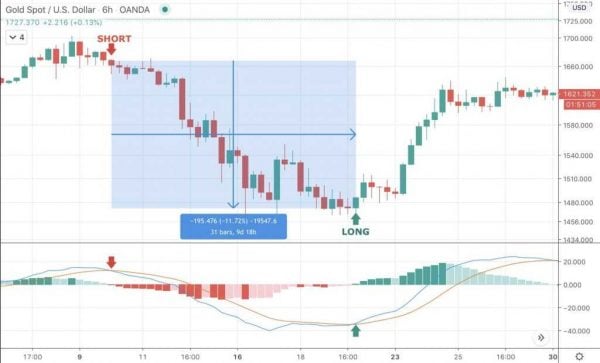
In the above example, a short swing trade is opened the moment the bearish crossover happens. Further bearish price action can be seen as the histogram goes deeper in the red. A close of the short swing trade, while opening a new long swing trade would happen the moment the bullish crossover occurred.
The resulting trade provided an over 11% return in less than ten days. That’s more than one percent.
Ichimoku Kinko Hyo Swing Trading Strategies
The Ichimoku Kinko Hyo or Ichimoku indicator for short, offers an “at a glance” look at time and price action built into a complex visual tool. While the Ichimoku indicator can be complex, with many unique tools such as the cloud and various span lines, it can also be used to create a very straightforward and simple strategy for swing trading.
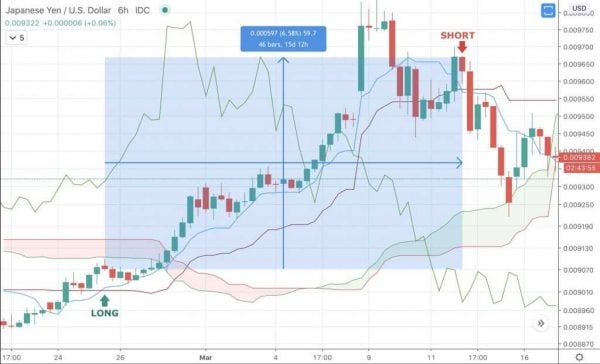
In the chart above, the senkou span A and senkou span B have crossed bullish before February 20th, then crossed bearishly after the 11th of March. A long trade is taken with the bullish crossover, and a short position is opened at the bearish crossover.
Note how price was supported by the blue span line. Upon the first break of the line, it is a signal to watch for a reversal of the uptrend if price closes below both lines and then crosses bearish.
Parabolic SAR (Stop and Reverse) Swing Trading Strategies
The Parabolic SAR indicator is one of the easiest to use but also the most versatile tools. Although it can be a lagging indicator, due to this attribute it also makes an extremely helpful tool for setting trailing stop losses.
A trailing stop loss moves the stop loss down or up with price action, setting it increasingly in higher profit. By placing a stop loss below the SAR dots, although the stop may be hit, it will close in profit and due to the way the tool functions, there’s a high probability that there is also a reversal taking place and closing out was the best move anyway.
In the above example, a short trade is opened the moment the price pierces the SAR dot from the upside and through it to the downside. A close and long trade should then be opened when the inverse happens and a price candle crosses back upward through the dots from beneath.
Using this simple strategy, an over 15% trade was possible in crude oil markets.
Relative Strength Index (RSI) Swing Trading Strategies
The Relative Strength Index or RSI, is a trend strength measuring indicator that also signals when an asset is extremely overbought or oversold. However, these conditions can remain at extreme peaks during strong trends in one direction or the other.
During ranging markets, the RSI can be a powerful profitable swing trading tool.
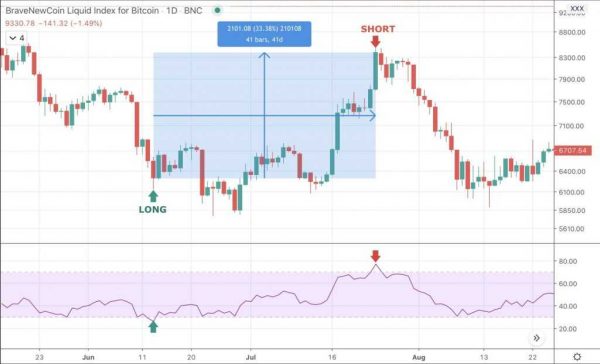
In the BTCUSD chart above, the RSI touches the bottom of the gauge where a long trade would be opened when the asset becomes oversold. A head and shoulders formation eventually forms, and confirms, pushing price higher to overbought levels.
A short trade would be opened and the long closed once the RSI showed that overbought conditions were reached.
Bollinger Bands Swing Trading Strategies
Bollinger Bands are a unique tool that wraps the price action within two bands. The Bollinger Bands are made up of a simple moving average, and then two standard deviations of that moving average. These tools can provide a variety of signals, but for swing trading, a pass below the SMA confirms a position should be taken.
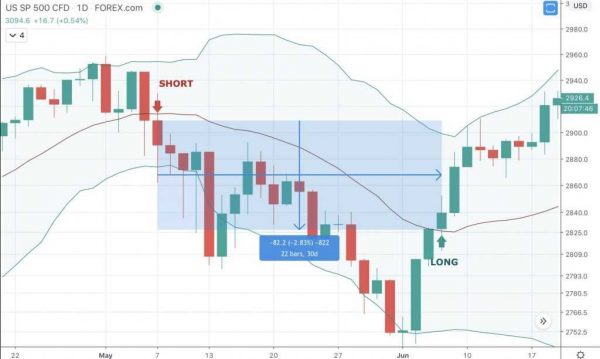
In the above example, the S&P 500 fell below the SMA around May 7, when a short trade would have been opened. The trade would be closed and a new swing long opened as price passed through the SMA once again.
Note that this is among the more conservative approaches to using the Bollinger Bands, but results in less overall risk.
Bollinger Bands can also be used to measure overall volatility or lack thereof, via the widening and tightening of the two bands.
Stochastic Oscillator Swing Trading Strategies
The Stochastic Oscillator or stoch for short, is another momentum measuring indicator. Stoch notes when trends are running out of steam, but also gives a buy or sell signal with a bullish or bearish crossover of the two lines.
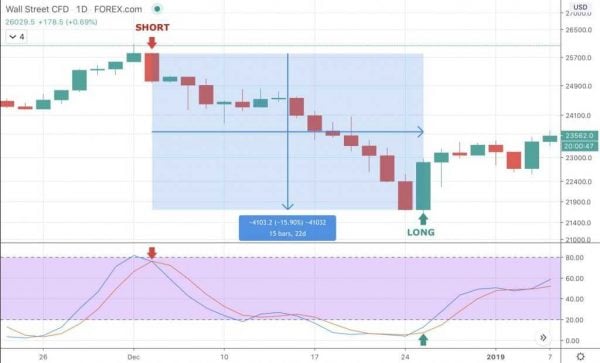
In the above example, a near flawless trade is set up when the bearish crossover occurs. A short trade can be held all the way down until the bullish crossover occurs, resulting in an over 15% gain on the Dow. A long trade would be opened at the bullish crossover for yet another successful swing trade.
Day Trading Versus Swing Trading
Day trading is very frequent, highly active trades, that last anywhere from minutes to hours. At most, a day trader may hold a position overnight, but that is extreme for a day trader.
Day traders are always on the hunt for the next move, even sometimes during the position they are already in. Day traders may even take multiple positions inside a single day, in the same asset.
Day traders may even buy an asset at the start of a day’s trading session, then sell it by lunch time, and buy it again before the day has ended.
Day traders can stack up profits much more quickly, however, they are constantly tied to their trading desks due to the need to always be watching short term trades and preparing for the next.
Day traders can also rack up a lot of fees with this active of a trading technique, whereas swing traders take so few trades in between, that fees rarely become an issue.
Day traders also focus almost solely on technical analysis and news, rather than fundamental analysis that impacts the long-term health of an asset.
Swing traders on the other hand focus on medium term trades, lasting anywhere from days to weeks. Occasionally, traders last upwards of a month or more, but still fall within the range or “weeks” that would otherwise define a swing trader.
Swing traders are typically less stressed, can manage positions at their leisure or from their mobile, and enjoy much more freedom than day traders.
Highly successful swing traders will make just as much money, with far less effort. But everyone is different, and finding the right trading style that is right for you is what is most critical to generating profit time and time again.
Conclusion: How Swing Trading Can Be a Successful Trading Strategy
Now that you have learned all of the basics and building blocks of swing trading, you have a strong enough foundation that you can continue to reference this helpful guide and use the outlined swing trading strategies to develop and execute a trading plan of your own.
You also know how to place a limit order, how to spot entries and exits, even learned how to set a stop loss properly using certain tools and technical analysis indicators. You are fully armed with all that’s necessary to become a profitable swing trader.
To further hone your skills, be sure to continue your learning via online trading courses, books, trading podcasts, or by following other top traders from around the globe.
In addition, you can also try swing trading for yourself using a free swing trading account from PrimeXBT, an award-winning Bitcoin-based multi-asset trading platform.
PrimeXBT offers CFDs for forex, crypto, stock indices, and more. These trading instruments are the ideal assets for swing trading. These assets have also never been more volatile meaning there is opportunity located around every corner of the market.
Using PrimeXBT, swing traders can go long or go short on up to 50 or more assets all under one roof, ranging from digital to traditional assets.
The advanced trading platform features a highly reliable trading engine and deep liquidity. Up to 99.9% uptime means that no swing positions are ever put in jeopardy.
Built-in charting software is included for detailed and in-depth technical analysis, allowing traders to plan their next move and overall strategy without ever having to leave the platform.
Many customizations are available through a variety of widgets, and the user interface is great for novices and experienced traders alike.
A fast, 60-second registration process and low minimum deposit make the platform accessible for anyone, even with only a small amount of capital.
PrimeXBT offers all the tools necessary to maximize profit and minimize risk, and the variety of assets offered created an opportunity for unrivaled portfolio diversification.
Bank-grade security, two-factor authentication, and compulsory address whitelisting protect all accounts, denominated in Bitcoin.
For those that need additional assistance, friendly customer service is always available 24/7 via live chat, and a help center on the company website is filled with a wealth of additional information and guides.


